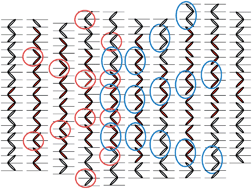Smooth transitions between biaxial intermediate smectic phases
Abstract
The possibility of smooth transitions between biaxial smectic subphases via defect propagation is considered on the basis of our theoretical approach reported previously [Emelyanenko et al., Phys. Rev. E, 2006, 74, 011705]. The extrapolation of our results suggests an infinite number of biaxial intermediate phases, each one existing stably only at a particular temperature, and not over a range. Three- and four-layer subphases are confirmed to be important due to the minor differences between them and their neighboring subphases. Some other subphases (including a six-layer subphase) are also found to be very similar to the neighboring subphases. Several sets of intermediate phases are recognized. Each set represents a combination of two typical fragments of the smectic structure in various proportions.


 Please wait while we load your content...
Please wait while we load your content...